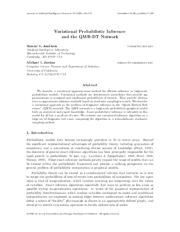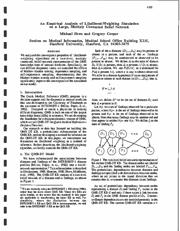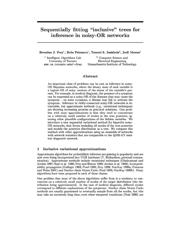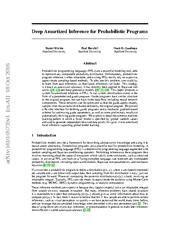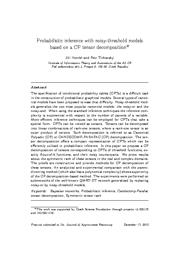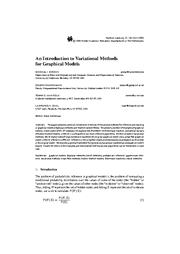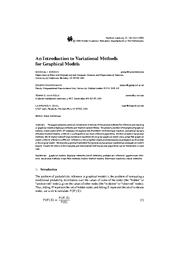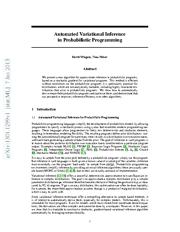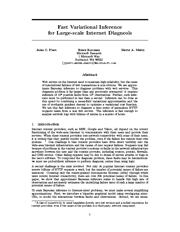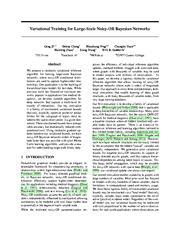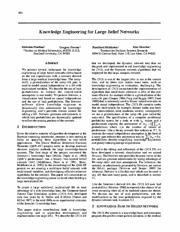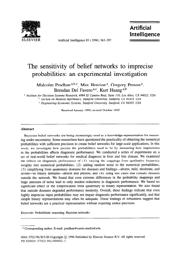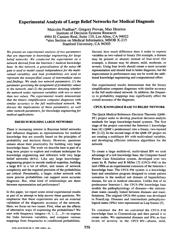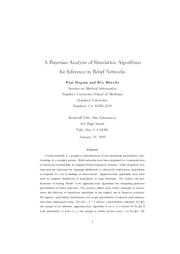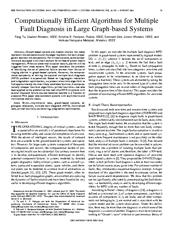A copy of this work was available on the public web and has been preserved in the Wayback Machine. The capture dates from 2006; you can also visit the original URL.
The file type is application/pdf.
Filters
Variational Probabilistic Inference and the QMR-DT Network
1999
The Journal of Artificial Intelligence Research
We describe a variational approach to the problem of diagnostic inference in the 'Quick Medical Reference' (QMR) network. ...
The QMR network is a large-scale probabilistic graphical model built on statistical and expert knowledge. Exact probabilistic inference is infeasible in this model for all but a small set of cases. ...
Acknowledgements We w ould like to thank the University of Pittsburgh and Randy Miller for the use of the QMR-DT database. ...
doi:10.1613/jair.583
fatcat:ovji6y3c7vczrcd7a3cohd4un4
An Empirical Analysis of Likelihood-Weighting Simulation on a Large, Multiply-Connected Belief Network
[article]
2013
arXiv
pre-print
We analyzed the convergence properties of likelihood- weighting algorithms on a two-level, multiply connected, belief-network representation of the QMR knowledge base of internal medicine. ...
Specifically, on two difficult diagnostic cases, we examined the effects of Markov blanket scoring, importance sampling, demonstrating that the Markov blanket scoring and self-importance sampling significantly ...
QMR-DT model. ...
arXiv:1304.1141v1
fatcat:qdxmf65qpfdthenn4peob5g764
Sequentially Fitting "Inclusive" Trees for Inference in Noisy-OR Networks
2000
Neural Information Processing Systems
We compare this method with other approximations using an ensemble of networks with network statistics that are comparable to the QMR-DT medical diagnostic network. ...
We introduce a new sequential variational method for bipartite noisy-OR networks, that favors including all modes of the true posterior and models the posterior distribution as a tree. ...
Results on QMR-DT type networks Using the structural and parameter statistics of the QMR-DT network given in Shwe et al. (1991) we simulated 30 QMR-DT type networks with roughly 600 diseases each. ...
dblp:conf/nips/FreyPJM00
fatcat:vaadtu4rabbf5dr2ggyi6dlp6y
Deep Amortized Inference for Probabilistic Programs
[article]
2016
arXiv
pre-print
Unfortunately, probabilistic program inference is often intractable, and existing PPLs mostly rely on expensive, approximate sampling-based methods. ...
This strategy is known as amortized inference; it has recently been applied to Bayesian networks and deep generative models. This paper proposes a system for amortized inference in PPLs. ...
The views and conclusions contained herein are those of the authors and should not be interpreted as necessarily representing the official policies or endorsements, either expressed or implied, of DARPA ...
arXiv:1610.05735v1
fatcat:rwtryr6w6bhclo2q6sotwvnvbu
Probabilistic inference with noisy-threshold models based on a CP tensor decomposition
2014
International Journal of Approximate Reasoning
The experiments were performed on subnetworks of the well-known QMRT-DT network generalized by replacing noisy-or by noisy-threshold models. ...
The tensor decomposition offers a compact representation of CPTs which can be efficiently utilized in probabilistic inference. ...
Cooper from University of Pittsburgh for the structural part of QMR-DT model. We also thank Petr Savicky for his hints towards the CP decomposition in the complex domain. ...
doi:10.1016/j.ijar.2013.12.002
fatcat:5lmzxsqlcvccbefyja6kqvr62i
An Introduction to Variational Methods for Graphical Models
[chapter]
1998
Learning in Graphical Models
We present a number of examples of graphical models, including the QMR-DT database, the sigmoid belief network, the Boltzmann machine, and several variants of hidden Markov models, in which it is infeasible ...
This paper presents a tutorial introduction to the use of variational methods for inference and learning in graphical models (Bayesian networks and Markov random fields). ...
Acknowledgments We wish to thank Brendan Frey, David Heckerman, Uffe Kjaerulff, and (as always) Peter Dayan for helpful comments on the manuscript.
Notes ...
doi:10.1007/978-94-011-5014-9_5
fatcat:jtcxyl7wvfeflb2h7uacbygriy
:{unav)
2012
Machine Learning
We present a number of examples of graphical models, including the QMR-DT database, the sigmoid belief network, the Boltzmann machine, and several variants of hidden Markov models, in which it is infeasible ...
This paper presents a tutorial introduction to the use of variational methods for inference and learning in graphical models (Bayesian networks and Markov random fields). ...
Acknowledgments We wish to thank Brendan Frey, David Heckerman, Uffe Kjaerulff, and (as always) Peter Dayan for helpful comments on the manuscript.
Notes ...
doi:10.1023/a:1007665907178
fatcat:qrdodrap5fevncyagbxnuoylbq
Automated Variational Inference in Probabilistic Programming
[article]
2013
arXiv
pre-print
We present a new algorithm for approximate inference in probabilistic programs, based on a stochastic gradient for variational programs. ...
We show how to automatically derive mean-field probabilistic programs and optimize them, and demonstrate that our perspective improves inference efficiency over other algorithms. ...
We tested automated variational inference on two common inference benchmarks: the QMR-DT network (a binary bipartite graphical model with noisy-or directed links) and LDA (a popular topic model). ...
arXiv:1301.1299v1
fatcat:jchutrnmkfeqbob27lk5oz3hy4
Fast Variational Inference for Large-scale Internet Diagnosis
2007
Neural Information Processing Systems
Inference can be done at this speed by combining a mean-field variational approximation and the use of stochastic gradient descent to optimize a variational cost function. ...
The inference is fast enough to analyze network logs with billions of entries in a matter of hours. ...
Future publications will include conclusions of such analysis, and implications for web services and the Internet at large. ...
dblp:conf/nips/PlattKM07
fatcat:ad346fr2srgp5etsud7lhijwcy
Variational Training for Large-Scale Noisy-OR Bayesian Networks
2019
Conference on Uncertainty in Artificial Intelligence
We propose a stochastic variational inference algorithm for training large-scale Bayesian networks, where noisy-OR conditional distributions are used to capture higher-order relationships. ...
Using stochastic gradient updates based on our variational bounds, we learn noisy-OR Bayesian networks orders of magnitude faster than was possible with prior Monte Carlo learning algorithms, and provide ...
Michael Hughes and Jialu Liu provided helpful information about baseline topic models and inference algorithms. ...
dblp:conf/uai/0001CNYZXS19
fatcat:ibqkwflconhsfjjx3pxi67266m
Knowledge Engineering for Large Belief Networks
[chapter]
1994
Uncertainty Proceedings 1994
Netview generates sub-networks in which leak probabilities are dynamically updated to reflect the missing portions of the network. ...
We describe the use of leak probabilities to enforce the closed-world assumption in our model. We present Netview, a visualization tool based on causal independence and the use of leak probabilities. ...
The authors would like to thank K. C. Chang and R. Fung for their graph layout algorithm on which NetView's layout method is based, and R.Miller for access to the CPCS knowledge base. ...
doi:10.1016/b978-1-55860-332-5.50066-3
fatcat:56t3r5tq7fewxjvrizwbirt7ja
The sensitivity of belief networks to imprecise probabilities: an experimental investigation
1996
Artificial Intelligence
3) simplifying from quatemary domains for diseases and findings-absent, mild, moderate, and severe-to binary domains-absent and present, and (4) using test cases that contain diseases outside the network ...
We conducted a series of experiments on a set of real-world belief networks for medical diagnosis in liver and bile disease. ...
Acknowledgements This work was supported by NSF grant IRI 91-20330 to the Institute for Decision Systems Research. ...
doi:10.1016/0004-3702(96)00002-1
fatcat:bejph5g6wbdp7ao4tlpquirwjq
Experimental analysis of large belief networks for medical diagnosis
1994
Proceedings. Symposium on Computer Applications in Medical Care
We study two network parameters, (1) the parameter governing the assignment of probability values to the network, and (2) the parameter denoting whether the network nodes represent variables with two or ...
In this network, a generalization of the noisy-OR gate is used to model causal independence for the multivalued variables, and leak probabilities are used to represent the nonspecified causes of intermediate ...
The authors thank R.Miller for providing us with access to the CPCS knowledge base, and to Lyn Dupre for her editorial input. ...
pmid:7950030
pmcid:PMC2247817
fatcat:qdg62uuv75gtlk2qhokiaqtida
A Bayesian analysis of simulation algorithms for inference in belief networks
1993
Networks
For real ; < 1 and for a probabilistic inference Pr xje], the output of an inference approximation algorithm is an ( ; )-estimate of Pr xje] if with probability at least 1 ? ...
A belief network is a graphical representation of the underlying probabilistic relationships in a complex system. ...
Acknowledgments This work was supported by the National Science Foundation under grant IRI-9108385 and by Rockwell International Science Center IR&D funding. ...
doi:10.1002/net.3230230506
fatcat:f6aiazpoxfhrtlfthm2727m5r4
Computationally efficient algorithms for multiple fault diagnosis in large graph-based systems
2003
IEEE transactions on systems, man and cybernetics. Part A. Systems and humans
Graph-based systems are models wherein the nodes represent the components and the edges represent the fault propagation between the components. ...
Based on Lagrangian relaxation and subgradient optimization, we present a heuristic algorithm to find approximately the most likely candidate fault set. ...
ACKNOWLEDGMENT The authors would like to thank the reviewers for valuable comments that significantly improved the readability of the paper. ...
doi:10.1109/tsmca.2003.809222
fatcat:m3u543qfqbexbptkxpf2ommjwe
« Previous
Showing results 1 — 15 out of 55 results

